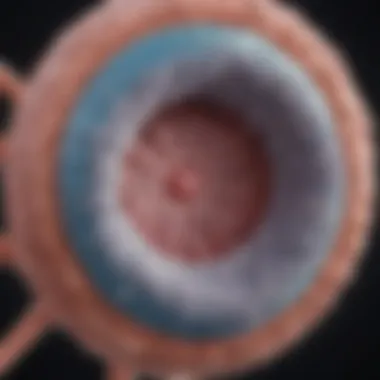Giant Cell Tumor of Tendon Sheath: Recovery Insights


Intro
Giant cell tumors of the tendon sheath represent a distinct pathology that often requires surgical intervention. As these tumors can lead to discomfort and impaired function of the affected limb, understanding the recovery process post-surgery is essential for both patients and healthcare professionals. This section introduces the importance of an in-depth exploration of the surgical recovery journey, covering aspects like care strategies, rehabilitation guidelines, and the significance of personalized recovery plans.
Recovery from surgery is not merely a process of physical healing; it encompasses emotional and psychological dimensions as well. Engaging with the recovery timeline and potential complications can help demystify the journey ahead. Patients informed in advance about what to expect can navigate the challenges of rehabilitation with greater confidence.
In this article, we will take a detailed look at the surgical techniques used to treat giant cell tumors of the tendon sheath. We will provide insights into postoperative care protocols and recovery milestones, collectively enhancing the understanding of both patients and their caregivers. The goal is to foster an environment where informed decision-making supports optimal recovery outcomes.
Understanding Giant Cell Tumors of the Tendon Sheath
The investigation of giant cell tumors of the tendon sheath is essential for both medical practitioners and patients navigating treatment options. Giant cell tumors are benign but can cause severe discomfort and dysfunction in the affected area. Recognizing their nature is the first step toward developing effective treatment strategies.
Understanding these tumors allows healthcare professionals to provide informed care during surgery and recovery. This knowledge also aids patients in setting realistic expectations as they undergo treatment. By familiarizing oneself with this condition, individuals can mitigate the uncertainties often linked to surgical procedures and rehabilitation pathways.
Additionally, an awareness of giant cell tumor characteristics can lead to early diagnosis and intervention. The earlier these tumors are addressed, the better the outcomes. Patients benefit from insights into symptoms, treatment options, and the recovery process. Such understanding promotes an informed patient experience. Thus, this examination lays the groundwork for the topics that follow, fostering a comprehensive view of surgery and recovery related to these tumors.
Definition and Characteristics
Giant cell tumors of the tendon sheath are typically soft tissue tumors that arise from the synovial lining around tendons. According to current medical literature, these tumors can appear as nodular masses and are primarily located in the hands and feet. Patients may notice swelling that can be painless, but as these tumors grow, they may compress surrounding structures, leading to discomfort and impaired function.
These tumors usually affect adults more than children, and can recur, which emphasizes the importance of proper surgical intervention. They are categorized based on histological findings, showing multinucleated giant cells. The tumors do not metastasize; however, their local aggressiveness can pose challenges. Surgery often becomes necessary not only to alleviate symptoms but also to prevent recurrence during recovery.
Pathophysiology
The exact cause of giant cell tumors of the tendon sheath is not completely understood. However, research indicates that they might arise from the synovial fibroblasts and macrophages in the tendon sheath. The histological composition reveals a mixture of inflammatory and proliferative cells. Increased levels of vascularization in these tumors also contribute to their growth and potential complications.
In terms of pathophysiology, giant cell tumors typically exhibit benign behavior but can present in a locally aggressive manner. They may penetrate surrounding soft tissue structures, impacting nearby nerves and blood vessels. Over time, this aggressive local behavior can lead to significant damage if not addressed early through an appropriate surgical approach. Thus, recognizing the underlying biological behavior is critical for both surgical planning and postoperative recovery strategies.
Symptoms and Diagnosis
Patients may present with a range of symptoms, often dependent on the tumor's size and location. Common indicators include swelling near a tendon, discomfort with movement, and in some cases, a palpable mass. Symptoms usually prompt individuals to seek a medical evaluation.
To diagnose giant cell tumors, clinicians typically use a combination of physical examination and imaging studies. Magnetic resonance imaging (MRI) allows for visualization of the tumor's extent and relationship to surrounding anatomical structures. In certain instances, a biopsy may be performed to confirm the diagnosis through histological examination.
Early diagnosis is crucial because it impacts treatment decisions. An accurate understanding of these tumors and their presentation can expedite the path to effective surgical management.
Surgical Approaches to Treatment
Surgical intervention is a cornerstone in the management of giant cell tumors of the tendon sheath. It is critical to understand the various surgical approaches available as they influence the recovery trajectory and overall outcomes for patients. Selecting the appropriate surgical method is essential, as it directly impacts healing, functionality, and recurrences. Factors such as the tumor's location, patient’s health status, and surgical expertise affect the choice made by the clinician.
Preoperative Assessment
A thorough preoperative evaluation is vital before any surgical procedure, especially for giant cell tumors of the tendon sheath. This assessment involves imaging studies such as MRI or Ultrasound to determine the tumor's size and extent. Moreover, the patient's overall health status must be evaluated. This includes understanding the patient’s medical history, current medications, and any underlying conditions that may complicate surgery. Comprehensive assessments help in tailoring an individualized surgical plan and optimizing potential outcomes.
Surgical Techniques
Open Surgical Excision
Open surgical excision is a widely used technique for the management of giant cell tumors of the tendon sheath. This method involves direct surgical access to the tumor, allowing for extensive removal of the growth. The key characteristic of open excision is that it provides the surgeon with a clear view, which helps in ensuring complete resection of the tumor. This technique is beneficial because it can effectively reduce the risk of recurrence. However, it often comes with a longer recovery time compared to minimally invasive options, which can be a disadvantage for patients seeking a quicker return to daily activities.
Arthroscopic Procedures
Arthroscopic procedures present an alternative to open surgical excision, utilizing minimally invasive techniques. This approach involves small incisions and the use of an arthroscope to visualize and remove the tumor. A notable feature of arthroscopic methods is that they typically result in less soft tissue damage and scarring, which can lead to a quicker recovery. However, it may not always be suitable depending on the tumor's size or location. The limited visibility can sometimes complicate complete removal, posing a risk of recurrence, which is an important consideration for both surgeon and patient.
Combined Approaches


Combined approaches leverage both open excision and arthroscopic techniques. This hybrid method aims to maximize tumor removal while minimizing recovery times and soft tissue damage. The key characteristic of combined approaches is their flexibility; surgeons can adapt their strategy based on real-time observations during surgery. This method can be particularly beneficial for complex cases where the tumor has infiltrated surrounding tissues. While offering the potential for optimal outcomes, the complexity of combined techniques may require surgeons with specialized skills, which can limit availability in some settings.
Post-Surgery Expectations
After surgery, patients have various expectations depending on the technique used and individual conditions. Understanding these can help alleviate anxiety and prepare for the recovery process. Common post-surgical outcomes include pain management, physical therapy initiation, and regular monitoring by healthcare professionals. Patients should be advised about what to expect during their recovery journey. Knowing potential signs of complications, such as infection or impaired healing, is essential for timely intervention.
Overall, surgical approaches to treat giant cell tumors of the tendon sheath play a significant role in the recovery and long-term prognosis of patients. Each method has its specific advantages and disadvantages, underscoring the need for a personalized treatment plan.
Recovery Timeline
Understanding the recovery timeline after surgery for a giant cell tumor of the tendon sheath is critical for patients and medical professionals. This timeline provides a structured overview of what to expect during different phases of recovery. It helps in setting realistic goals and managing expectations. A well-defined recovery timeline guides patients in their rehabilitation journey and allows for better communication with healthcare providers. Moreover, it highlights the importance of adhering to follow-up appointments and rehabilitation protocols, ensuring complications are minimized and optimal healing is achieved.
Immediate Postoperative Phase
The immediate postoperative phase begins right after the surgery. In this phase, the patient is monitored closely to observe any immediate reactions to anesthesia and to manage pain. Pain management is often achieved through medications, which may include narcotics or non-steroidal anti-inflammatory drugs. Elevation of the surgical site is encouraged to reduce swelling.
During the first 24 to 48 hours, patients might be advised to rest and avoid any unnecessary movement. Ice packs may be applied to manage inflammation. Healthcare providers typically emphasize the importance of keeping the surgical site clean and dry. It is essential to follow specific instructions about wound care to prevent infection.
Short-Term Recovery
Short-term recovery usually spans the first few weeks post-surgery. During this time, patients may begin gradual mobility exercises, depending on their specific situation and the surgeon’s advice. Physical therapy may be introduced, focusing on gentle stretching and movements to avoid stiffness.
Patients will continue to monitor for any signs of complications such as increased swelling, redness, or unexpected pain. Follow-up appointments are crucial during this period to ensure that healing is progressing. Many patients find that discussions with their medical team help in understanding their progress and the healing process.
Key points for short-term recovery include:
- Gradual reintroduction of movement
- Importance of adhering to prescribed exercises
- Regular assessment of the surgical site
Long-Term Recovery Considerations
Long-term recovery encompasses months after the surgery. While the initial healing might progress well, patients should stay vigilant about their overall recovery. Activities that stress the tendon or require heavy lifting may need to be restricted for a more extended period.
At this stage, patient education becomes vital. Understanding how to properly incorporate strengthening exercises into daily routine facilitates better recovery outcomes. Adopting healthy lifestyle choices, such as nutrition and hydration, can also significantly impact recovery.
Regular follow-ups are essential to monitor for recurrence of tumors or develop potential complications related to the surgery. Engaging in community support groups or forums can provide additional emotional support.
"Recovery timelines can feel overwhelming, but consistency in following medical advice and protocols can lead to successful outcomes."
Ultimately, adhering to a structured timeline allows patients to navigate their recovery with informed decisions, potentially improving their quality of life post-surgery.
Rehabilitation Protocols
Rehabilitation after surgery for giant cell tumors of the tendon sheath is a critical component of the recovery journey. This phase ensures that patients regain strength, flexibility, and function in the affected area. Proper rehabilitation protocols can significantly reduce the risk of complications and promote optimal healing.
A structured approach to rehabilitation allows patients to focus on their recovery goals. By following evidence-based physical therapy guidelines, patients can make meaningful progress in a controlled manner. These protocols often include individualized assessments and tailored exercise plans, which are essential for addressing specific needs.
Physical Therapy Guidelines
Physical therapy plays a vital role in the recovery process. Initially, the goal is to manage pain and reduce inflammation. Therapists often recommend gentle stretching and mobility exercises soon after surgery. The primary focus is to avoid stiffness while protecting surgical sites. Patients should expect to engage in:
- Range of motion exercises: These help maintain joint flexibility without stressing the injured area.
- Pain management techniques: Ice application and gradual heat therapy can facilitate recovery.
As recovery progresses, the emphasis shifts towards strengthening muscles surrounding the tendon. It's crucial to advance gradually to prevent overexertion and ensure safety during rehabilitation.
Strengthening Exercises
Strengthening exercises are critical once the initial healing phase is complete. These exercises increase muscle power, support joint stability, and promote functional movements. It generally starts with:


- Isometric exercises: These exercises engage muscles without joint movement. They serve to build strength while minimizing stress on healing tissues.
- Progressive resistance training: As tolerance improves, resistance bands or light weights can be introduced, emphasizing controlled movements to protect from injury.
The inclusion of core stability workouts may also be beneficial. A strong core aids in overall body mechanics, allowing the injured area to function efficiently. Tailoring the intensity of these exercises to individual capabilities is essential for maximizing outcomes.
Mobility and Function Restoration
Restoring mobility and function is often the final phase of rehabilitation. A comprehensive protocol integrates functional movements that replicate daily activities. This includes practicing:
- Walking programs: They aid in regaining normal gait patterns, which is vital for overall mobility.
- Task-specific functional training: Involves simulating tasks such as grasping, lifting, and pushing, which are relevant to the patient's daily life.
In addition, therapists may guide patients through tailored exercises focusing on balance. This aspect is crucial for preventing falls and improving overall coordination. Regular assessment throughout this phase ensures that the rehabilitation plan adapts to the patient's progress.
The potential for recovery from surgery of giant cell tumors of the tendon sheath can be greatly improved through adherence to structured rehabilitation protocols. Individualized care plans maximize results and enhance long-term outcomes.
Monitoring Recovery Progress
Monitoring recovery progress after surgery for giant cell tumors of the tendon sheath is essential for ensuring a positive outcome. This proactive approach helps in early identification of potential issues and enables timely intervention. By keeping track of different recovery facets, patients can better understand their healing journey and healthcare providers can provide tailored advice to enhance recovery.
Follow-Up Appointments
Follow-up appointments serve as a critical component in the postoperative care plan. These visits allow healthcare professionals to assess the surgical site, ensure there are no signs of infection, and evaluate the patient's overall progress. During these appointments, the doctor may conduct physical examinations and request imaging studies, like ultrasound or MRI, to monitor the tumor site.
In addition to monitoring recovery, these appointments provide patients with a platform to discuss their concerns. Questions regarding pain, mobility, or any unusual symptoms can be addressed directly with the surgeon or physician.
The frequency of follow-up visits may vary depending on individual circumstances but often occurs at regular intervals such as every few weeks initially, tapering off as recovery progresses.
Assessing Complications
Assessing complications is vital for postoperative success. Patients should be aware of various complications associated with surgery for giant cell tumors of the tendon sheath. Common concerns include potential infections, persistent pain, and recurrence of the tumor itself.
Regular assessment can help in identifying these issues early on. Signs of infection might include increased redness, swelling, or discharge from the surgical site. Keeping a close eye on these symptoms is crucial. If any complications arise, management strategies can be implemented promptly, which often leads to improved long-term outcomes.
Patient Self-Assessment Techniques
Patient self-assessment techniques empower individuals to take an active role in their recovery process. This involves monitoring symptoms and making notes of any changes in pain levels, range of motion, or daily functioning. Engaging in self-assessment encourages patients to communicate effectively with their healthcare providers during follow-up visits.
Patients can use simple tools to aid their self-assessment:
- Pain Scales: Rating pain levels on a scale of 1-10 helps in tracking pain trends over time.
- Activity Logs: Keeping a journal of activities and any difficulties experienced supports discussions with medical staff and can help in adjusting rehabilitation protocols.
- Symptom Checklists: Documenting any symptoms like swelling or tenderness can guide further evaluations.
By being proactive and engaged, patients can optimize their recovery and ultimately improve their quality of life.
Long-Term Outcomes and Patient Quality of Life
Long-term outcomes following surgery for giant cell tumors of the tendon sheath have significant implications for both recovery and overall quality of life. Understanding these outcomes is crucial. Patients often seek to comprehend what awaits them in terms of functional abilities, pain management, and their return to everyday activities. Moreover, the long-term effects of treatment extend beyond mere physical health. They encompass psychological well-being and social reintegration.
Factors Influencing Recovery
Several factors can affect recovery outcomes, including:
- Surgical Technique: The method used for removal impacts healing and function. Techniques such as open excision or arthroscopic surgery can yield different results.
- Tumor Characteristics: The size and grade of the tumor may dictate the extent of surgery required, influencing recovery time and potential complications.
- Patient's General Health: Pre-existing health conditions can complicate recovery. A healthier patient may recover faster and with fewer complications.
- Rehabilitation Efforts: The dedication to physical therapy and rehabilitation plays a pivotal role in restoring function. Adherence to prescribed exercises can lead to better outcomes.
Understanding these influencing factors allows patients and healthcare professionals to tailor rehabilitation protocols effectively.
Psychological Considerations
Psychological effects following surgery for giant cell tumors can be profound. Patients often experience anxiety concerning the possibility of tumor recurrence. Support systems, whether through family, friends, or professional counseling, are essential. Elements to consider include:


- Mental Health: Emotional well-being significantly affects physical recovery. Mental health challenges can arise during the recovery period, making it vital for patients to have access to mental health resources.
- Support Networks: Engagement with support groups can aid in sharing experiences and strategies for coping with challenges. Social interactions can bolster a positive outlook.
- Mindfulness Techniques: Practices such as meditation and stress management can enhance psychological resilience.
Promoting psychological health is an integral part of improving overall quality of life.
Return to Daily Activities
The ultimate goal for many post-surgery patients is a return to their pre-surgery lifestyle. This aspect encompasses:
- Gradual Reintroduction: Patients often need guidance on how to gradually return to daily tasks and hobbies. Initially limiting activities may be necessary to avoid stressing the surgical site.
- Functional Goals: Setting practical, achievable goals can motivate recovery. Patients should work with healthcare providers to outline what activities they can resume safely.
- Work and Leisure: Many patients worry about resumeing their jobs and engaging in leisure activities. Communication with employers regarding necessary accommodations can facilitate a smoother transition back to work.
Ultimately, successful reintegration into daily life contributes significantly to the overall sense of recovery.
Long-term outcomes are not solely about physical health but inherently encompass emotional and social dimensions as well. This holistic view fosters improved quality of life.
Potential Complications
The examination of potential complications following surgery for giant cell tumors of the tendon sheath is crucial for both patients and healthcare providers. Understanding these risks helps in planning, monitoring recovery, and preparing for possible interventions. This section provides an in-depth look at the key complications associated with this surgical procedure, emphasizing the importance of awareness and preventive strategies.
Infection Risks
Infection is one of the most significant risks associated with any surgical procedure, including excisions of giant cell tumors. Postoperative patients are particularly susceptible to infections due to surgical wounds. Factors such as the patient's overall health, the surgical environment, and the technique used can influence infection rates.
Symptoms of infection may include redness, swelling, increased pain, and sometimes fever. Prompt identification and treatment of infections are essential to prevent further complications. After surgery, patients should keep their surgical sites clean and follow the guidelines provided by their healthcare team.
Proper hygiene and wound care are essential for minimizing infection risks.
Recurrence of Tumor
Recurrence of the giant cell tumor represents another critical complication that can affect patients long-term. Studies indicate that despite successful initial surgery, there remains a chance of the tumor returning. Factors influencing recurrence include the tumor's grading and the completeness of the initial removal.
Healthcare teams often schedule regular follow-up visits to monitor for signs of recurrence. Imaging studies might also be used to detect any regrowth. Recognizing a recurrence early can lead to timely surgical intervention, thus improving outcomes.
Scarring and Adhesion Formation
Scarring and adhesion formation are common after any surgical procedure. After surgery for giant cell tumors of the tendon sheath, patients may experience varying degrees of scarring, which can lead to limitations in function and mobility. Adhesions may also form as a result of surgery, connecting tissues that are normally separate, which can disrupt the movement of tendons around joints.
To manage these issues, physical therapy plays a vital role. Patients should engage in prescribed mobility exercises to promote healing and minimize fibrous tissue development. Understanding the potential for scarring and adhesions allows patients to prepare for possible rehabilitative measures and to set realistic expectations about their recovery journey.
End
The conclusion of this article highlights essential elements related to the recovery journey from surgery for giant cell tumors of the tendon sheath. Understanding the comprehensive nature of recovery is crucial for both patients and healthcare professionals. It serves not just to summarize the information shared earlier but also to reinforce the importance of individual recovery experiences.
First, it is vital to ensure that patients grasp the nuances of their own recovery. This encompasses recognizing the postoperative phase, which involves pain management and early rehabilitation steps. Patients need to be well-informed about what to expect in their recovery trajectory to minimize anxiety and facilitate better healing.
Second, the benefits of a structured rehabilitation protocol cannot be overlooked. Tailored physical therapy and specific strengthening exercises play a critical role in restoring function. An organized plan promotes adherence to rehabilitation and helps avoid complications like stiffness or loss of mobility.
Furthermore, ongoing monitoring helps to catch any signs of complications early. Emphasis on follow-up appointments is significant to ensure that the healing process is on track. This vigilance can lead to better long-term outcomes and higher quality of life.
Ultimately, a personalized approach to recovery should encompass all aspects, from rehabilitation protocols to regular assessments, ensuring that the patient remains central in their healing journey.
Summary of Key Points
- Individual understanding of the recovery process is crucial for optimal healing.
- Structured rehabilitation protocols enhance recovery and reduce complications.
- Ongoing monitoring through follow-up appointments is vital for tracking progress.
- The integration of psychological support can improve overall patient experience post-surgery.
Importance of Personalized Recovery Plans
Personalized recovery plans are integral for successful rehabilitation following surgery for giant cell tumors of the tendon sheath. These plans consider the unique circumstances of each patient, focusing on specific needs and recovery goals.
Key aspects of personalized recovery plans include:
- Assessment of Individual Health Conditions: A thorough preoperative evaluation allows healthcare providers to tailor rehabilitation strategies based on unique patient conditions or previous health issues.
- Customization of Rehabilitation Protocols: Effective recovery depends on personalized exercises and timelines that suit the individual’s life, activity level, and previous abilities.
- Feedback Mechanisms: Continuously adapting recovery plans based on patient feedback helps in addressing any discomfort or challenges faced during rehabilitation. This adjusts the pace and type of therapy engaged.
In essence, personalized recovery plans foster a sense of ownership in the healing process and promote an efficient return to daily activities.







